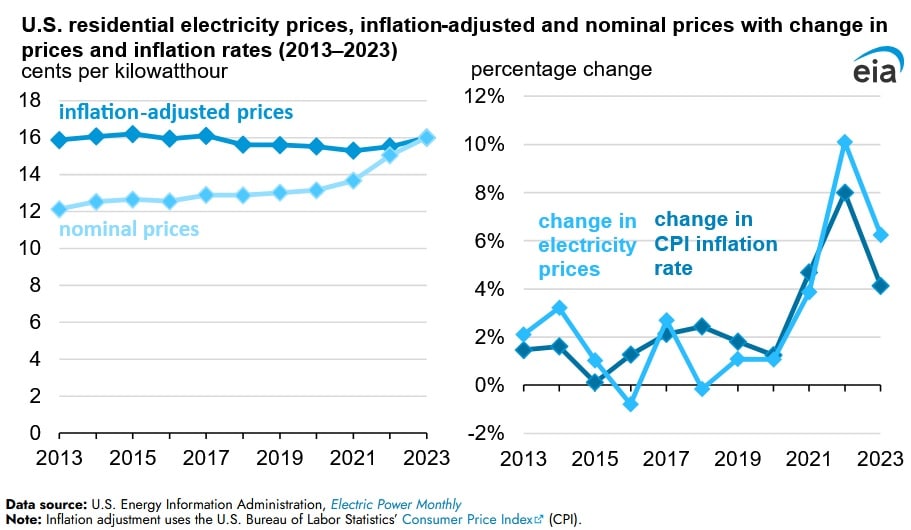Residential Electricity Prices Mirrored Inflation Trends Over The Past Decade: EIA

The change in average U.S. residential electricity prices has largely tracked the rate of inflation over the last 10 years, rising by less than one percent in inflation adjusted terms from 2013-2023, according to an Sept. 11 report published by the U.S. Energy Information Administration.
Majority of the states across the U.S. regulate residential power markets through public utilities commission. Some states have deregulated electricity markets that permit households to select among competitive suppliers to deliver their power. Charges to cover the cost of distribution and transmission are recouped through rate regulation.
Regulated electric utilities could request electricity rate increases, in order to pay for enhancements to transmission and distribution. The proposed electricity rate increases must be signed off by a public utilities commission. The commission usually analyses the proposed expenditure increases against rises in the Consumer Price Index (CPI) as a potential justification for whether or not to approve the electricity rate increase request. Aside from the CPI, other potential reasons for increasing rates can be due to growing investment in distribution or transmission, higher expenditures for investment in new, innovative technologies or significant changes in the commodity price.
Over the last decade, electricity price increases in the majority of the states declined within a few percentage points of the inflation. In some states, the difference can vary significantly. New England and California saw real prices over the last 10 years rise by over two percent on an annual basis. Utah and Nebraska saw the biggest declines in real prices.
California’s real electricity price increased from around 21 cents per kWh during 2013 to nearly 30 cents per kWh in 2023, a yearly average increase of 2.8 percent. The increase can be attributed to higher costs and lower sales. Investments in grid modernization and renewable energy sources led to higher expenditures, as well as higher operational and maintenance costs from wildfires and other natural disasters. New England’s real electricity price increased from around 21 cent per kWh during 2023 to nearly 29 cents per kWh in 2023, a yearly average increase of 2.6 percent. The increase can be attributed to higher costs of fuel heating and natural gas.
Over the last 10 years, Utah (2.1 percent) and Nebraska (2 percent) witnessed the largest yearly decline in real electricity prices. The price decline can be attributed to an already well developed transmission network, relatively low population densities, surplus capacity to deal with increasing demand and easy accessibility to a diverse range of energy sources.
EnerKnol Pulses like this one are powered by the EnerKnol Platform—the first comprehensive database for real-time energy policy tracking. Sign up for a free trial below for access to key regulatory data and deep industry insights across the energy spectrum.
ACCESS FREE TRIAL


